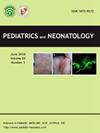Adrenal hemorrhage in neonates: Incidence, perinatal characteristics and follow-up outcomes
IF 2.3
4区 医学
Q2 PEDIATRICS
引用次数: 0
Abstract
Background and objectives
Neonatal adrenal hemorrhage (NAH) is relatively uncommon in neonates and it is often noted accidently by abdominal ultrasonogram. Few studies discussed risk factors for and impacts of NAH. This study aimed to assess incidence, perinatal characteristics and follow-up outcomes in neonates with adrenal hemorrhage.
Methods
This was a retrospective cohort study in a single institute from April 2008 to August 2018. All neonates who received abdominal ultrasonogram within seven days-of-life were recruited and divided in to 2 groups according to the presence of NAH. The perinatal characteristics and anthropometric measurements, the follow-up course and the clinical impact of NAH were reviewed in detail.
Results
7217 neonates had received abdominal ultrasonogram within seven days-of-life and 29 of them (0.4%) were diagnosed with NAH. Mean gestation age was 38 ± 1.2 weeks and mean birth weight was 3406 ± 403 g. Most infants (96.6%) had unilateral hemorrhage over the right adrenal gland. Compared with the control group, infants with NAH were significantly heavier (3406 vs. 3094 gm, p < 0.001), longer in body length (50.1 vs. 48.8 cm, p < 0.001) and wider in chest girth (33.2 vs. 32.4 cm, p = 0.006). They also tended to be delivered via vaginal delivery with vacuum-extraction rather than cesarean section. The prevalence of nuchal cord, neonatal jaundice and subgaleal hemorrhage was higher in the NAH group. The hemorrhage area of adrenal gland had a positive correlation with the peak bilirubin level (r = 0.422, p < 0.001) and the days to resolution (r = 0.198, p = 0.033). All infants had resolution of AH before 7 months of age.
Conclusions
NAH occurred more frequently in heavier neonates that were delivered via vaginal delivery with vacuum extraction. The hemorrhage involved mostly over the right adrenal gland. Neonatal jaundice was the major comorbidity. All infants had spontaneous resolution of AH before 7 months of age.
新生儿肾上腺出血:发病率、围产期特征和随访结果。
背景和目的:新生儿肾上腺出血(NAH)在新生儿中相对少见,通常是通过腹部超声波检查意外发现的。很少有研究讨论新生儿肾上腺出血的风险因素及其影响。本研究旨在评估肾上腺出血新生儿的发病率、围产期特征和随访结果:这是一项回顾性队列研究,于 2008 年 4 月至 2018 年 8 月在一家研究所进行。所有在出生七天内接受腹部超声检查的新生儿均被纳入研究对象,并根据是否存在肾上腺出血分为两组。详细回顾了NAH的围产期特征、人体测量、随访过程和临床影响:结果:7217 名新生儿在出生后 7 天内接受了腹部超声波检查,其中 29 名(0.4%)被确诊为 NAH。大多数婴儿(96.6%)右侧肾上腺单侧出血。与对照组相比,患有非肾上腺素血症的婴儿体重明显增加(3406 克对 3094 克,P):经阴道分娩并使用真空吸引器的体重较大的新生儿更容易出现非肾上腺性出血。出血主要涉及右侧肾上腺。新生儿黄疸是主要并发症。所有新生儿都在7个月大之前自发缓解了AH。
本文章由计算机程序翻译,如有差异,请以英文原文为准。
求助全文
约1分钟内获得全文
求助全文
来源期刊

Pediatrics and Neonatology
PEDIATRICS-
CiteScore
3.10
自引率
0.00%
发文量
170
审稿时长
48 days
期刊介绍:
Pediatrics and Neonatology is the official peer-reviewed publication of the Taiwan Pediatric Association and The Society of Neonatology ROC, and is indexed in EMBASE and SCOPUS. Articles on clinical and laboratory research in pediatrics and related fields are eligible for consideration.
 求助内容:
求助内容: 应助结果提醒方式:
应助结果提醒方式:


